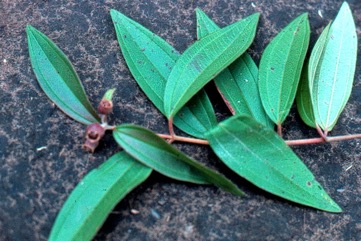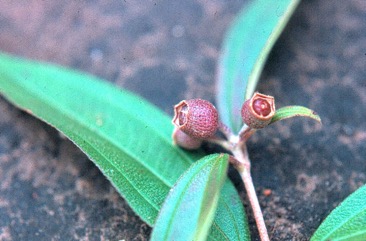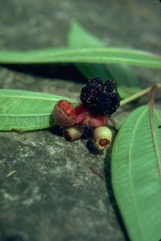Native Lasiandra, Blue tongue

A tropical and subtropical plant. The plants mostly grow in moist soils. They will grow on a range of soils. It does best in full sunlight. It cannot tolerate frost. The plants occur in coastal areas in open forest. It suits hardiness zones 10-12.
Also known as:
Bei bai, Bie chong na ma ha jia, Harendong, Lidah biru
Synonyms
- Melastoma denticulatum Labill. Melastoma malabathricum auct. non L.
- Melastoma polyanthum Bl.
- See Melastoma candidum
Edible Portion
- Fruit, Roots, Flowers
Where does Native Lasiandra grow?
Found in: Asia, Australia, China, East Africa, India, Indochina, Indonesia, Madagascar, Malaysia, Pacific, Papua New Guinea, PNG, Philippines, Polynesia, SE Asia
Notes: There are about 22 Melastoma species. The flesh of the fruit stains the mouth.
Status: In Papua New Guinea a very minor wild edible fruit seen in the Western Province and also recorded from Manus.
Growing Native Lasiandra, Blue tongue
Cultivation: Plants can be grown from seed. They can also be grown from cuttings. Regular pruning is helpful.
Edible Uses: The ripe fruit are eaten raw. (The flesh stains the mouth.) The roots are eaten raw. Honey is found in the old flowers.
Production: Plants are fast growing. In Australia, plants flower all year round but more commonly from December to March.
Nutrition Info
per 100g edible portion| Edible Part | Energy (kcal) | Protein (g) | Iron (mg) | Vitamin A (ug) | Vitamin c (mg) | Zinc (mg) | % Water |
|---|---|---|---|---|---|---|---|
| - | - | - | - | - | - |
Native Lasiandra, Blue tongue Photos



References
Bodkin, F., 1991, Encyclopedia Botanica. Cornstalk publishing, p 692 (As Melastoma polyanthum)
Borrell, O.W., 1989, An Annotated Checklist of the Flora of Kairiru Island, New Guinea. Marcellin College, Victoria Australia. p 99
Brock, J., 1993, Native Plants of Northern Australia, Reed. p 256 (As Melastoma polyanthum)
Cherikoff V. & Isaacs, J., The Bush Food Handbook. How to gather, grow, process and cook Australian Wild Foods. Ti Tree Press, Australia p 200
Cooper W & Cooper W T, 1994, Fruits of the Rain Forest. RD Press p 186
Cribb, A.B. & J.W., 1976, Wild Food in Australia, Fontana. p 40 (As Melastoma polyanthum)
Dunlop, C.R., Leach, G.J. & Cowie, I.D., 1995, Flora of the Darwin Region. Vol 2. Northern Territory Botanical Bulletin No 20. p 140
Elliot, W.R., & Jones, D.L., 1993, Encyclopedia of Australian Plants suitable for cultivation. Vol 6. Lothian. p 375
Etherington, K., & Imwold, D., (Eds), 2001, Botanica's Trees & Shrubs. The illustrated A-Z of over 8500 trees and shrubs. Random House, Australia. p 475
Fu, Yongneng, et al, 2003, Relocating Plants from Swidden Fallows to Gardens in Southwestern China. Economic Botany, 57(3): 389-402
Greig, D., 1996, Flowering Natives for Home Gardens. Angus & Robertson. p 267
Hibbert, M., 2002, The Aussie Plant Finder 2002, Florilegium. p 195
Hinton, B & B., 1982, A Wilderness in Bloom. Wildflowers of tropical Australia. p 46
Jones D, L, 1986, Ornamental Rainforest Plants in Australia, Reed Books, p 228, 340
Levitt, D., 1981, Plants and people. Aboriginal uses of plants on Groote Eylandt. Australian Institute of Aboriginal Studies, Canberra. p 100 (As Melastoma polyanthum)
Low, T., 1991, Wild Food Plants of Australia. Australian Nature FieldGuide, Angus & Robertson. p 59
Luo, B., et al, 2019, Wild edible plants collected by Hani from terraced rice paddy agroecosystem in Honghe Prefecture, Yunnan, China. Journal of Ethnobiology and Ethnomedicine 15:56
Molyneux, B. and Forrester, S., 1997, The Austraflora A-Z of Australian Plants. Reed. p 139
Nicholson, N & H., 1996, Australian Rainforest Plants 2, Terania Rainforest Publishing. NSW. p 41
Paczkowska, G. & Chapman, A.R., 2000, The Western Australian Flora. A Descriptive Catalogue. Western Australian Herbarium. p 294
Pearson, S. & A., 1992, Rainforest Plants of Eastern Australia. Kangaroo Press p 144
Peekel, P.G., 1984, (Translation E.E.Henty), Flora of the Bismarck Archipelago for Naturalists, Division of Botany, Lae, PNG. p 418, 416 (As Melastoma polyanthum)
Romanowski, N., 2007, Edible Water Gardens. Hyland House. p 109
Scarth-Johnson, V., 2000, National Treasures. Flowering Plants of Cooktown and Northern Australia. Vera Scarth-Johnson Gallery Association. Cooktown, Australia. p 94
Stanley, T. D. & Ross, E. M., 1986, Flora of south-eastern Queensland Volume 2. Queensland Government p 219
Sukarya, D. G., (Ed.) 2013, 3,500 Plant Species of the Botanic Gardens of Indonesia. LIPI p 673 (Also as Melastoma malabathricum)
Townsend, K., 1994, Across the Top. Gardening with Australian Plants in the tropics. Society for Growing Australian Plants, Townsville Branch Inc. p 295
Wheeler, J.R.(ed.), 1992, Flora of the Kimberley Region. CALM, Western Australian Herbarium, p 548
Yallakool Reserve Plant List July 1, 2009 Off internet
Yunupinu Banjgul, Laklak Yunupinu-Marika, et al. 1995, Rirratjinu Ethnobotany: Aboriginal Plant Use from Yirrkala, Arnhem Land, Australia. Northern Territory Botanical Bulletin No 21. Parks and Wildlife Commission of the Northern Territory. p 56.